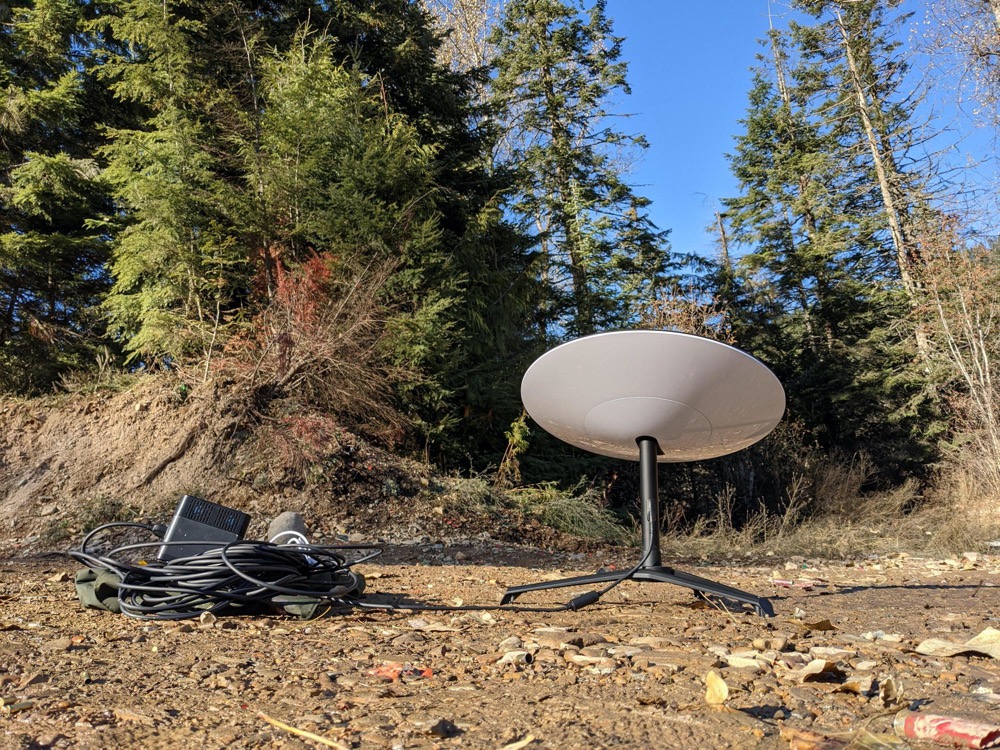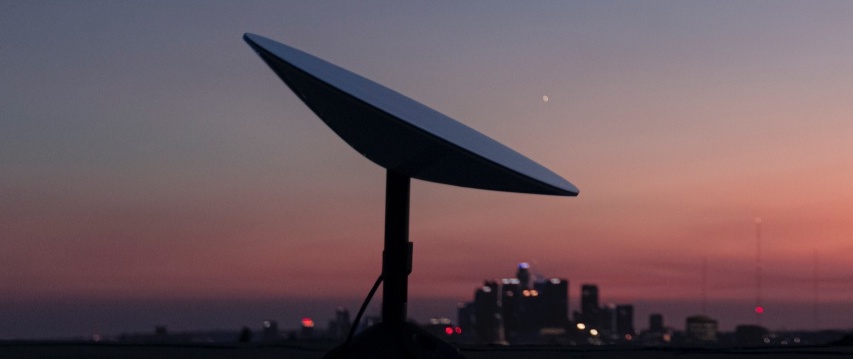
SpaceX Starlink engineers answered questions in a Reddit AMA (Ask Me Anything) on Saturday, covering topics such as data caps (which they hope to never implement), when the public beta will expand to more users, and how the satellite-broadband service will expand and change in the future.
"Starlink is an extremely flexible system and will get better over time as we make the software smarter. Latency, bandwidth, and reliability can all be improved significantly," the engineers wrote under the Reddit username "DishyMcFlatface," which is also SpaceX's nickname for the Starlink satellite dish.
Here are some highlights from the AMA.
No data caps “at this time”
When asked if users will ever face data caps, the Starlink team gave a vague answer: "At this time, the Starlink beta service does not have data caps."
While that response covered the present but not the future, a subsequent comment from DishyMcFlatface gave a more detailed answer that suggests SpaceX is trying to avoid data caps:
So we really don't want to implement restrictive data caps like people have encountered with satellite Internet in the past. Right now we're still trying to figure a lot of stuff out—we might have to do something in the future to prevent abuse and just ensure that everyone else gets quality service.
Expanded beta in January—no bribes required

Many people who haven't been able to get the Starlink beta are eagerly awaiting updates on availability, and the AMA provided an answer. SpaceX is "steadily increasing network access over time to bring in as many people as possible," the Starlink team wrote. "Notably, we're planning to move from a limited beta to a wider beta in late January, should give more users an opportunity to participate."
SpaceX CEO Elon Musk gave a similar update on Twitter a few weeks ago when a user asked when the beta will come to Florida. "Lower-latitude states need more satellites in position, so probably January," Musk wrote at the time.
As before, people hoping to get Starlink can enter their email and service address on the Starlink website and hope to hear back. Bribes apparently won't help. When one Reddit user asked, "How are beta users chosen and what's a good bribe amount?" the Starlink team answered, "No bribes necessary, our goal is serve everyone eventually."
More engineers needed
The Starlink team told Reddit users several times that SpaceX is looking for more engineers. In the answer about when the beta will expand, DishyMcFlatface wrote, "If you really want to help drive that, the best thing you can do is send great software engineers over to Starlink to help make it happen."
Over a dozen jobs in Starlink production design, product design, and software are available, and links to the job posts can be found in this DishyMcFlatface comment. "We are super excited about the initial response and future potential of Starlink, but we still have a ton to learn," the Starlink team wrote. "If you know any great people who can help us with that, please have them email their resume to starlink@spacex.com."
Will Starlink work away from home?
A few weeks ago, we wrote about a Starlink beta user who took the satellite dish and a portable power supply to a national forest in Idaho, where he was able to get fast Internet service. But that doesn't mean you can take the dish just anywhere, as SpaceX currently only promises that it will work at each beta user's service address.
One Reddit user who lives and works on a boat docked in South Florida wanted to know if Starlink will provide service on the open seas. "A mobile system that gives me reliable connectivity will truly set me free to roam the coastal US, Bahamas, and eventually beyond," the user wrote.
Starlink answered:
Right now, we can only deliver service at the address you sign up with on starlink.com. You might get lucky if you try to use Starlink in nearby locations, but service quality may be worse.
Mobility options—including moving your Starlink to different service addresses (or places that don't even have addresses!)—is coming once we are able to increase our coverage by launching more satellites & rolling out new software.
SpaceX recently asked the Federal Communications Commission for permission to test Starlink user terminals "on seagoing platforms" and on private jets.
Storms and extreme temperatures
A Reddit user asked if the satellite dish will work in heavy wind, such as when mounted "on the tail of a flatbed trailer flying down the interstate into a collapsing thunderstorm." The SpaceX team said that is not a recommended use and that the "dish is not designed for tropical storms, tornadoes, etc."
One Reddit user who lives in Canada asked if the dish will work in temperatures as low as 45° below zero Celsius (that's 49° below in Fahrenheit). Starlink engineers responded that the dish is certified to operate from 30° below zero to 40° above zero on the Celsius scale (that's 22° below zero up to 104°F). SpaceX has performed "testing down to these cold temperatures with no issues."
Starlink satellite dishes "have self-heating capabilities to deal with a variety of weather conditions," the team also said. In the coming weeks and months, they plan to deploy software updates that will "upgrade our snow melting ability."
Space lasers
SpaceX revealed a few months ago that it is testing "space lasers" that can transfer data between satellites.
"The speed of light is faster in vacuum than in fiber, so the space lasers have exciting potential for low latency links," the Starlink team said on Reddit in response to a question about the space-laser testing. "They will also allow us to serve users where the satellites can't see a terrestrial gateway antenna—for example, over the ocean and in regions badly connected by fiber."
Space lasers won't play a major role in Starlink any time soon, though. "We did have an exciting flight test earlier this year with prototype space lasers on two Starlink satellites that managed to transmit gigabytes of data," the engineering team wrote. "But bringing down the cost of the space lasers and producing a lot of them fast is a really hard problem that the team is still working on."
Why coverage isn’t always great

One beta tester reported having "pretty frequent dropouts during usage," apparently due to obstructions between the satellite dish and sky. "Once there are more satellites deployed, how important will it be to have an absolutely obstruction-free view of the sky?" the user asked.
The Starlink engineering team answered as follows:
You should think about communication between the Starlink dish and the satellite in space as a 'skinny beam' between Dishy and the satellite. So, as the satellite passes quickly overhead, if there is a branch or pole between the dish and satellite you'll usually lose connection (note—obstructions generally cause outages and not reduced speeds!).
We're working on some software features that are going to make this much better and, long-term, the clearance you'll need is going to shrink as the constellation grows. So this will get much better!
Also, hot short-term tip! The satellites clump up around 53 degrees latitude (north and south). So I would focus on keeping that part of the sky clear as we keep improving this!
The Starlink team also answered a question about how the dish locates satellites. The dish "is able to electronically scan the sky in a matter of milliseconds and lock into the satellite overhead, even though it's traveling 17,500 mph overhead," DishyMcFlatface answered. "When it detects a satellite, the Starlink hones in on its position and makes a request to join the Internet. After that, the dish is able to download a schedule of which satellites to talk to next and with that it can point right at the satellites when the time comes."
The Starlink team is optimistic that performance won't suffer when the network is more widely used. "This is not going to be like your regular satellite Internet where it gets way too crowded—as we launch more satellites over time the network will get increasingly great, not increasingly worse," they wrote. SpaceX has US permission to launch nearly 12,000 satellites and is seeking authorization for another 30,000. SpaceX also has US approval to deploy 1 million user terminals and is seeking authorization for up to 5 million.
Reducing power use and latency
Noting that the Starlink dish uses about 100 watts of power, one user asked if that will be reduced to allow more usage scenarios that require portable power supplies, such as on a sailboat. Power reduction is "a key item we are focusing on for the future," the Starlink team said.
"We are working on software and network updates to allow your Starlink to go into a deeper power-savings mode to drop power consumption while still remaining connected to the network," the engineering team wrote.
Team members are also trying to reduce latency but noted that they are constrained by the speed of light. "Current Starlink satellites operate at 550km, where light travel time is 1.8 milliseconds to Earth. The round trip from your house to a gaming server and back is at best 4 times 1.8 milliseconds at these altitudes, or under 8 milliseconds," they wrote.
Latency is added when satellites are not directly overhead and when packet buffering is used to improve stability. Starlink traffic also travels through fiber on the Earth, and that's "an indirect pathway that is 1.5 times slower than photons in vacuum," the Starlink team said.
"We will continually fight to provide the best latency possible, especially to provide a stable and reactive experience for gamers," the team wrote.
IPv6, and “plug-and-play” user experience
The Starlink team covered several other topics, such as the transition to IPv6.
"We're testing out IPv6 now, and will roll it out soon! Once it's ready, you'll get both an IPv4 and an IPv6 address. IPv4 addresses are a limited resource—IPv6 is the future," the team wrote.
The people on the SpaceX team also discussed challenges they've faced in developing and managing Starlink. With about 800 satellites launched so far, the company is now operating "the world's largest satellite constellation. We have a very small operations team, so automated orbit guidance and collision avoidance was a must have feature. We tell satellites what their final orbital slot is and they figure out how to get there. For collision avoidance, we upload data on close approaches to relevant satellites multiple times a day, and the satellites then calculate on their own when and how to dodge something, if necessary."
Crucially, the team said it also focused on developing "a truly 'plug-and-play' experience for customers" and that SpaceX welcomes ideas from users about how to make the experience easier. "We've spent a lot of effort and have gone through tons and tons of creative ideas on how to make this as simple of an experience as possible—including mounting solutions, automated pointing of the dish, and general unboxing," the Starlink engineers wrote. As Musk has said, Starlink comes with "just two instructions, and they can be done in either order: point at sky, plug in."
Science - Latest - Google News
November 25, 2020 at 02:18AM
https://ift.tt/39aMgO3
SpaceX Starlink questions answered: “Wider beta” soon, no plan for data caps - Ars Technica
Science - Latest - Google News
https://ift.tt/2Kb7H4e
https://ift.tt/3ceUkwc
Bagikan Berita Ini

















0 Response to "SpaceX Starlink questions answered: “Wider beta” soon, no plan for data caps - Ars Technica"
Post a Comment